Key Annotation Features
LEADTOOLS continually updates annotation features. Some of these features alter the way annotations are displayed. Other features change or enhance the user interface. To maintain backward compatibility within version 14, most of these features were disabled by default, and had to be enabled by calling the LAnnotation::SetOptions function. Starting with LEADTOOLS version 15, these options will be enabled by default.
The following features are being introduced:
-
New Rubber Stamp Display Style
-
New XP Style Annotation Toolbar
-
New Alpha Background Fill Option
-
New Annotation Rotate Option
-
New Annotation Side Handles
-
New Annotation Multi-select
-
New Annotation Cursors
-
New ESC to Cancel
-
New Calibrate Ruler Feature
-
New Dot Dash Lines
-
New XML Format
-
New Text Annotation Options
The following paragraphs describe each feature in more detail.
Rubber Stamp Display Style
In previous versions of LEADTOOLS, you could draw any of 26 predefined rubber stamp annotations. While any of these metafiles can be changed, users have asked for more contemporary-looking defaults. LEADTOOLS has responded and developed new default images. The following figure displays a sample of the original style and the new style:
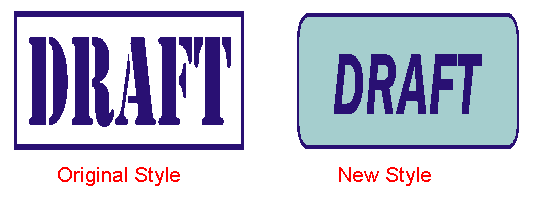
The new rubber stamp style can be enabled using the following code snippet:
L_VOID ExampleEnableOption(LAnnAutomation& annAutomation){L_UINT nRet, uOptions = 0;nRet = annAutomation.GetOptions( &uOptions);nRet = annAutomation.SetOptions( uOptions | OPTIONS_NEW_STAMP_METAFILES);}
XP Style Annotation Toolbar
The annotation toolbar has been updated to have a Windows-XP look and feel. As with previous versions of LEADTOOLS, the annotation toolbar can be customized with your own images.
This figure displays a sample of the original style and the new style.
For more information on toolbars, see the documentation for ANNBUTTON and the functions LAnnToolBar::FreeToolBarButtons, LAnnToolBar::GetToolBarButtons, LAnnToolBar::SetToolBarButtons
The new XP-style annotation toolbar can be enabled using the following code snippet:
L_VOID ExampleEnableOption(LAnnAutomation& annAutomation){L_UINT nRet, uOptions = 0;nRet = annAutomation.GetOptions( &uOptions);nRet = annAutomation.SetOptions( uOptions | OPTIONS_NEW_TOOLBAR);}
Alpha Background Fill Option
An alpha option that allows you to specify an alpha value from 0 (completely transparent background) to 255 (completely opaque background) inclusive.
The new alpha background fill option can be enabled using the following code snippet:
L_VOID ExampleEnableOption(LAnnAutomation& annAutomation){L_UINT nRet, uOptions = 0;nRet = annAutomation.GetOptions( &uOptions);nRet = annAutomation.SetOptions( uOptions | OPTIONS_NEW_ALPHA);}
When enabled, you can right-click an annotation object to display the Fill dialog with the new alpha option. Here you can enter an alpha value from 0 255 inclusive. The following figure displays the Fill dialog for the Stamp object: The following figure displays rectangle annotation objects using different alpha values:
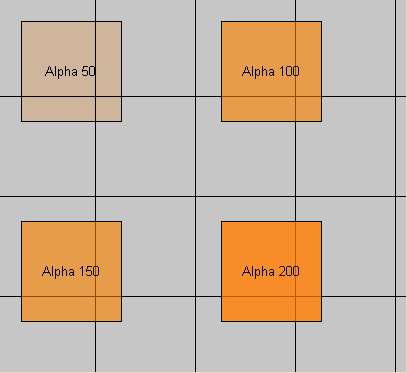
For more information, see the documentation for LAnnotation::GetFillMode and LAnnotation::SetFillMode.
Annotation Rotate Option
In previous versions of LEADTOOLS, annotation objects could be rotated by holding theThe following figure illustrates a rotate by dragging the "gripper" handle:

The following figure illustrates moving the "center" handle:
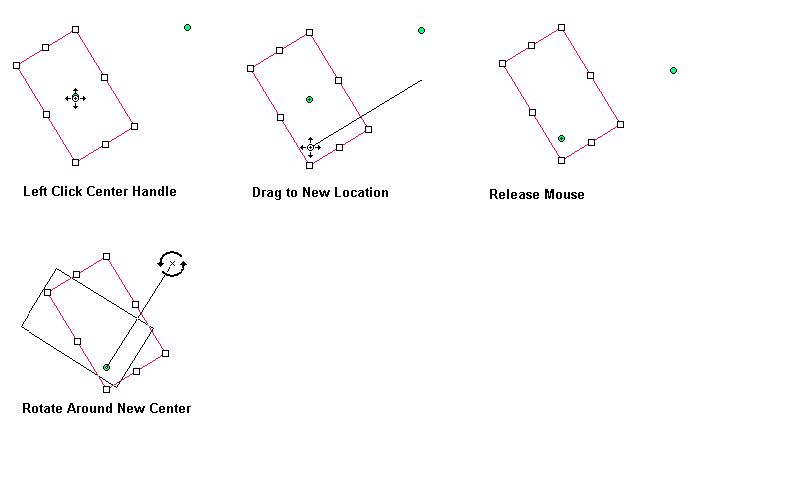
The rotate handles can be reset to a default location by right-clicking the annotation object, and selecting the Reset Rotate Handles option, as shown in the following figure:

The rotate handles can be globally hidden or displayed by right-clicking on the image (not an annotation object), and selecting the Hide Rotate Handles For All Objects option, as shown in the following figure:
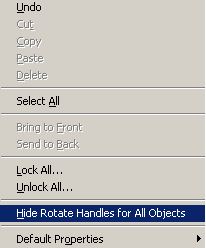
The new annotation rotate object can be enabled using the following code snippet:
L_VOID ExampleEnableOption(LAnnAutomation& annAutomation){L_UINT nRet, uOptions = 0;nRet = annAutomation.GetOptions( &uOptions);nRet = annAutomation.SetOptions( uOptions | OPTIONS_NEW_ROTATE);}
Annotation Side Handles
In previous versions of LEADTOOLS, rectangular annotation objects were displayed with four handles to manipulate the object. With this new feature, rectangular objects are displayed with four additional side handles. Dragging the side handles resizes the annotation object only in one dimension. Dragging the corner handles resizes the object in two dimensions, preserving the aspect ratio.
The new annotation side handles can be enabled using the following code snippet:
L_VOID ExampleEnableOption(LAnnAutomation& annAutomation){L_UINT nRet, uOptions = 0;nRet = annAutomation.GetOptions( &uOptions);nRet = annAutomation.SetOptions( uOptions | OPTIONS_NEW_ SIDE_HANDLES);}
The following figure displays a sample of the original style and the new style:
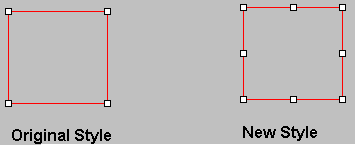
Annotation Multi-select
In previous versions of LEADTOOLS, you could select multiple objects and manipulate the objects by dragging any handle of any object. When moving a handle, the results were often not intuitive. With the new multi-select option, all selected objects are outlined with a multi-select border. The multi-select border has eight resize handles, and two rotate handles. Now, moving, resizing, and rotating multiply select objects is clear and easy to do.
The new annotation multi-select feature can be enabled using the following code snippet:
L_VOID ExampleEnableOption(LAnnAutomation& annAutomation){L_UINT nRet, uOptions = 0;nRet = annAutomation.GetOptions( &uOptions);nRet = annAutomation.SetOptions( uOptions | OPTIONS_NEW_ MULTI_SELECT);}
The following figure displays a sample of the original style and the new style:
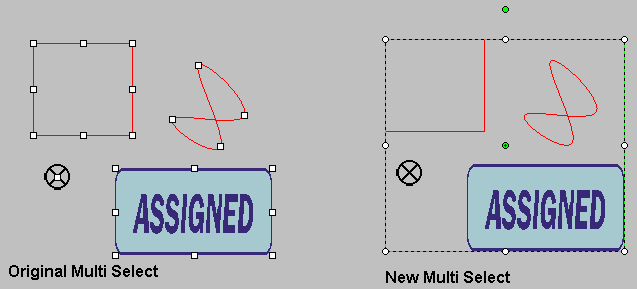
Annotation Cursors
This new feature displays different cursors for many tasks in automated annotation mode. This feature displays unique annotation cursors in the following situations:
-
When hovering over a rotation gripper handle
-
When hovering over a rotation center handle
-
When hovering over any of the eight size handlesan appropriate arrow cursor is displayed depending on the handle and the rotation of the annotation object.
-
When dragging a selection
-
When using any of the 30 annotation tools.
All annotation cursors can be changed to your own custom cursors by calling the LAnnAutomation::SetAutoCursor and LAnnAutomation::GetAutoCursor functions.
The new annotation cursors can be enabled using the following code snippet:
L_VOID ExampleEnableOption(LAnnAutomation& annAutomation){L_UINT nRet, uOptions = 0;nRet = annAutomation.GetOptions( &uOptions);nRet = annAutomation.SetOptions( uOptions | OPTIONS_NEW_ CURSORS);}
The following figure displays some of the new cursors:
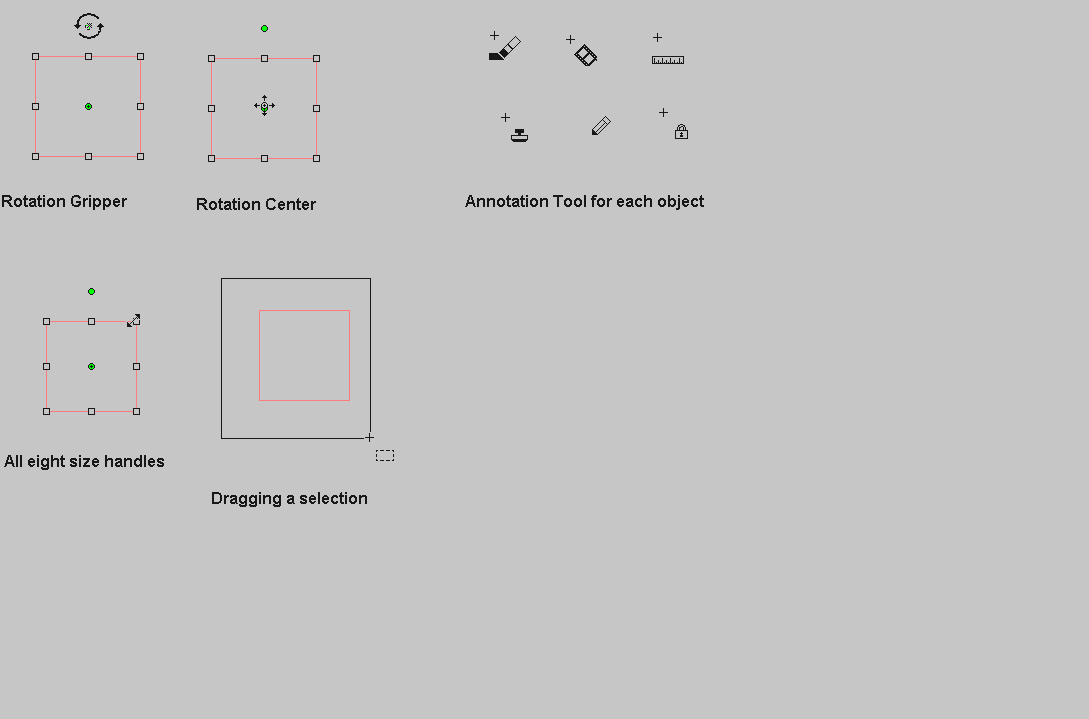
ESC to Cancel
In previous versions of LEADTOOLS, the ESC key was not set to cancel actions in annotation automation mode. With this new feature, a user can press the ESC key to cancel many actions in annotation automation mode. For example, when drawing an annotation, pressing ESC will cancel the annotation completely. When rotating, resizing, or moving an annotation, pressing ESC will cancel the action leaving the annotation unchanged.
The new ESC to Cancel feature can be enabled using the following code snippet:
L_VOID ExampleEnableOption(LAnnAutomation& annAutomation){L_UINT nRet, uOptions = 0;nRet = annAutomation.GetOptions( &uOptions);nRet = annAutomation.SetOptions( uOptions | OPTIONS_NEW_ ESC_CANCEL);}
Calibrate Ruler Feature
With this feature, a user can automatically calibrate a ruler to the desired size. This is useful when a user wants to interactively measure something in an image. Note that there are four annotations objects used for measuring:
- LAnnRuler
- LAnnPolyRuler
- LAnnCrossProduct
- LAnnProtractor
Any of these objects can be calibrated. To calibrate a ruler:
-
Load desired image.
-
Draw an LAnnRuler object and size to desired size. In this example, we will calibrate the diagonal to be 2 feet. The following figure displays an uncalibrated ruler:
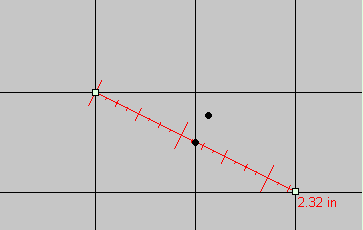
-
Right-click the LAnnRuler object and select Ruler Properties, and then Ruler, as shown in the following figure:
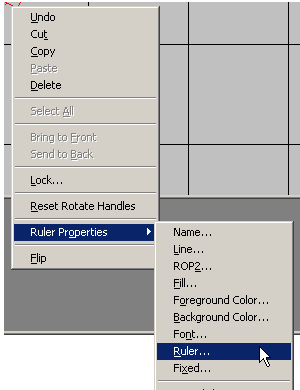
The following figure appears:
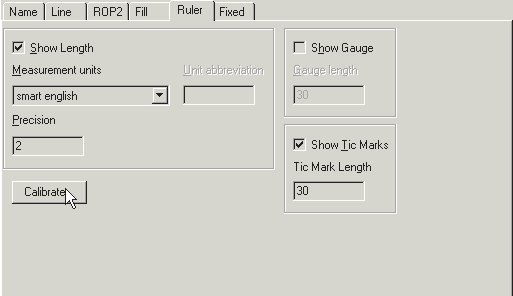
-
Click the Calibrate button to open the Calibrate Ruler dialog. The following figure displays:
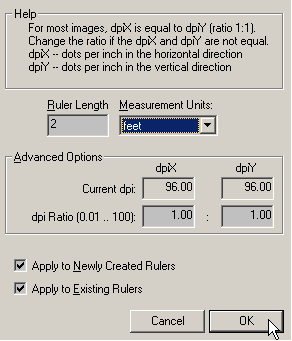
In the Calibrate dialog, set the Ruler Length to 2 and the Ruler Measurement to feet. Select the Apply to Newly Created Rulers check box. Click the OK button to close the Calibrate dialog. Click the OK button to save your selections and close the Ruler Properties dialog.
-
Draw a new ruler to measure any part of the image, as shown in the following figure:
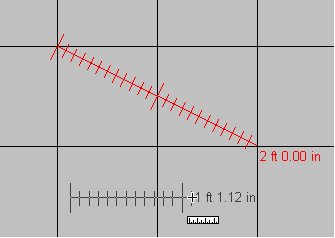
The new calibrate ruler feature can be enabled using the following code snippet:
L_VOID ExampleEnableOption(LAnnAutomation& annAutomation){L_UINT nRet, uOptions = 0;nRet = annAutomation.GetOptions( &uOptions);nRet = annAutomation.SetOptions( uOptions | OPTIONS_NEW_ CALIBRATE_RULER);}
For more information on calibrating rulers, see the documentation for LAnnotation::CalibrateRuler, and the topic Calibrating Annotation Ruler Objects.
Dot Dash Lines
Annotation objects can be drawn with thick lines of any style. The following example illustrates this:
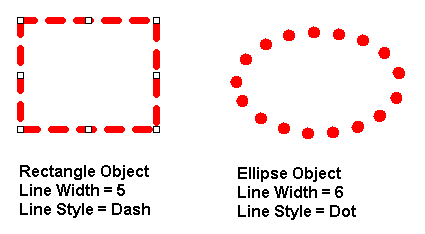
This feature can be enabled using the following code snippet.
L_VOID ExampleEnableOption(LAnnAutomation& annAutomation){L_UINT nRet, uOptions = 0;nRet = annAutomation.GetOptions( &uOptions);nRet = annAutomation.SetOptions( uOptions | OPTIONS_NEW_ DOT_DASH_LINES);}
XML Format
Annotations could be saved in one of two non-XML formats:
-
ANNFMT_NATIVE a text based file format for storing annotations
-
ANNFMT_ENCODED a binary file format for storing annotations
They can also be saved to a text-based format for annotations ANNFMT_XML. This format follows the XML (Extensible Markup Language) standards.
There are many advantages of using the ANNFMT_XML format:
-
It is both forward- and backward-compatible.
-
It is human readable.
-
Files using the ANNFMT_XML format can be easily modified using a standard text editor (i.e. notepad.exe).
-
It can be easily parsed using any standard XML parser.
-
It can be used with any of the growing number of utilities that work with XML.
This option does not need to be enabled using LAnnotation::SetOptions. To use this feature, simply pass the flag ANNFMT_XML to the annotation save functions. For more information, see the documentation for LAnnContainer::Save, LAnnContainer::SaveOffset, LAnnContainer::SaveMemory, LAnnContainer::Load, LAnnContainer::LoadOffset, LAnnContainer::LoadMemory.
Text Annotation Options
For the following text based annotations, you can now change the text color so that it is different from the border color. Also, you can optionally show or hide the text.
-
LAnnText
-
LAnnTextPointer
-
LAnnStamp
-
LAnnNote
-
LAnnPushPin
For the following text based annotations, you can now optionally show or hide the border.
-
LAnnText
-
LAnnStamp
These properties can also be set for the following annotation objects for purposes of recursion:
-
LAnnContainer
-
LAnnAutomation
-
LAnnButton
To see these new features:
-
Draw an LAnnText object.
-
Right-click the object.
-
Select Text Properties and then Text.
-
In the Text dialog, select the Show Border check box.
-
Click the Text Color button to change the color to blue. This figure displays the Text dialog.
-
The following figure displays the original text object before and after changing the text color to blue:
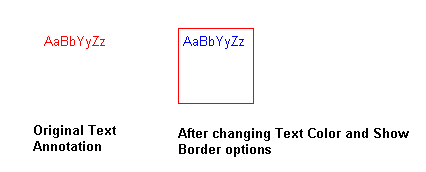
This feature can be enabled using the following code snippet.
L_VOID ExampleEnableOption(LAnnAutomation& annAutomation){L_UINT nRet, uOptions = 0;nRet = annAutomation.GetOptions( &uOptions);nRet = annAutomation.SetOptions( uOptions | OPTIONS_NEW_ TEXT_OPTIONS);}
For more information, see the documentation for the LAnnotation::SetTextOptions, and LAnnotation::GetTextOptions functions.
© 1991-2021 Apryse Sofware Corp. All Rights Reserved.
